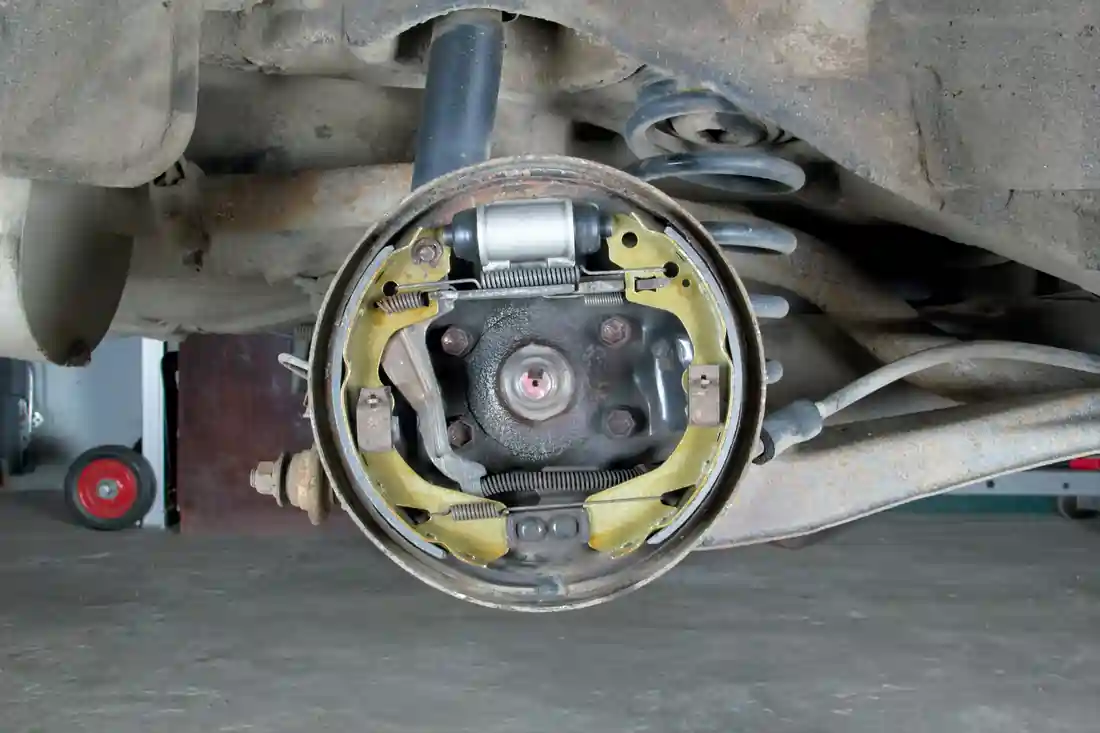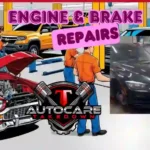Common brake problems can significantly impact your vehicle’s performance and safety.
Keeping your vehicle’s brakes in top condition is crucial for your safety and the safety of others on the road. Here are some common brake problems and how to identify them:

Common Brake Problems and How to Identify Them
Your vehicle’s braking system is essential for your safety, and understanding the signs of potential brake issues can help you avoid dangerous situations and costly repairs. Knowing how to identify common brake problems early can also prevent further damage to your car’s components. Below, we’ll go over the most frequent brake issues and what to look out for when they arise.
Worn Brake Pads
Brake pads are essential for safely stopping your vehicle, and over time, they wear down and need to be replaced. Here are some common signs to watch for when your brake pads are wearing out.
Squealing or Grinding Noises
One of the first signs of worn brake pads is a squealing or screeching noise when you press the brake pedal. This sound comes from the brake pad’s wear indicator, which is designed to alert you when the pads are nearing the end of their lifespan. If you begin to hear grinding noises, this means the pads are fully worn down, and the metal backing plate is rubbing against the brake rotor, which can lead to expensive damage.
Longer Stopping Distances
Worn brake pads can reduce your vehicle’s ability to stop quickly. You may notice that your car takes longer to come to a complete stop, especially in emergency situations. This is a clear sign that the pads need to be replaced before your braking system becomes less effective.
Vibrations or Pulsations in the Brake Pedal
If you feel vibrations or pulsations in the brake pedal when you press down on it, this could indicate unevenly worn brake pads. As the pads wear down inconsistently, they create an uneven braking surface, which causes the brake pedal to vibrate during use.
Visual Inspection of Brake Pads
You can also check your brake pads visually. If they appear thin or unevenly worn, or if you see cracks, it’s a clear indication that they need replacing. Keeping an eye on the thickness of your brake pads is an easy way to stay ahead of potential issues before they become bigger problems.
Related Brake Service: Brake Repair and Service
Leaking Brake Fluid
Brake fluid is essential for hydraulic pressure in the braking system. If you notice a clear puddle under your car or the brake pedal feels spongy, you might have a brake fluid leak. Check the brake lines, master cylinder, and calipers for wetness or drips. Immediate repair is necessary to prevent brake failure.
Related Brake Service: The Importance of Brake Fluid Flushes
Brake Caliper Issues
Brake calipers play a crucial role in your vehicle’s braking system. They house the brake pads and press them against the brake rotors to create the friction needed to stop your car. However, calipers can develop problems over time, such as sticking or seizing, which can lead to uneven braking and reduced braking power. Here are some common signs that your brake calipers may be malfunctioning.
Uneven Brake Pad Wear
When a caliper seizes or sticks, it can cause uneven pressure on the brake pads. This uneven force leads to one side of the brake pad wearing down faster than the other. Over time, this can compromise your braking performance, making it essential to check for uneven wear during regular brake inspections. If left unaddressed, it can also lead to damage to the brake rotor, increasing repair costs.
Vehicle Pulling to One Side
A clear indicator of a caliper problem is when your vehicle pulls to one side while braking. This happens because one of the calipers isn’t applying the same amount of pressure as the other. If a caliper is sticking, it could continuously apply pressure to one side of the car, causing it to veer in that direction when braking. This not only reduces control over the vehicle but also poses a serious safety hazard, particularly during emergency stops.
Spongy or Soft Brake Pedal
A soft or spongy feeling when you press the brake pedal can also be a sign of caliper issues. This may indicate that a caliper is leaking brake fluid or not functioning correctly, reducing the hydraulic pressure in the braking system. When this happens, your vehicle’s ability to stop efficiently is significantly diminished, and it’s crucial to address this issue promptly to avoid further damage to your brakes.
Warped Rotors
Brake rotors are crucial components of your braking system. They work in conjunction with the brake pads to create the friction needed to stop your vehicle. However, rotors can warp over time, particularly due to excessive heat from frequent or hard braking. When the rotors warp, it affects the smoothness of your braking and can cause noticeable symptoms. Below are some common signs that your rotors may be damaged.
Pulsing Sensation in the Brake Pedal
One of the most common indicators of warped rotors is a pulsing or vibrating sensation through the brake pedal when you apply the brakes. This occurs because the warped rotor surface creates uneven contact with the brake pads, leading to a pulsation effect. The more warped the rotors become, the more pronounced this pulsing will feel, making it difficult to stop your car smoothly.
Vibrations in the Brake Pedal or Steering Wheel
Warped rotors can also cause vibrations not only in the brake pedal but sometimes in the steering wheel as well, especially at higher speeds. The uneven rotor surface affects how the braking force is applied, leading to vibrations that can make controlling the vehicle more difficult. If you feel vibrations when braking, it’s a strong sign that your rotors may need to be resurfaced or replaced.
Squealing or Scraping Noises
In some cases, warped rotors can create squealing or scraping noises when you apply the brakes. This can happen if the rotors are uneven or have developed surface irregularities that make contact with the brake pads. These noises can also indicate other issues, such as worn brake pads, so it’s important to have the brakes inspected to determine the exact cause.
Visible Scoring or Grooves on the Rotor Surface
A visual inspection of your rotors may reveal scoring or grooves on the surface, which is a clear sign of rotor damage. These marks are typically caused by prolonged use of worn brake pads or uneven contact between the pads and the rotor. If you notice any deep grooves or scoring, it may be time to replace or resurface the rotors to restore smooth braking performance.
Read More: How to Know When Your Rotors Need Replacing
Soft or Spongy Brake Pedal
A soft or spongy brake pedal is a serious issue that can affect your vehicle’s ability to stop effectively. When you press the brake pedal and it feels unusually soft or lacks resistance, it’s a clear sign that the hydraulic pressure in your braking system is compromised. This can be caused by several factors, all of which should be addressed promptly to maintain safe braking performance.
Air in the Brake Lines
One of the most common causes of a soft brake pedal is air trapped in the brake lines. The braking system relies on fluid to transfer the force from your foot to the brake pads. When air enters the lines—due to a leak, improper brake bleeding, or aging components—it disrupts the hydraulic pressure. As a result, the brake pedal may feel spongy, making it difficult to stop your vehicle effectively. Removing the air through a process called bleeding the brake lines is essential to restore proper braking.
Brake Fluid Leak
Another frequent cause of a soft brake pedal is a brake fluid leak. Brake fluid is vital for creating the pressure needed to engage the brakes, and a leak in the brake lines, calipers, or master cylinder reduces the system’s ability to generate that pressure. This leads to a soft pedal and compromised braking power. If left unchecked, it can eventually result in brake failure. Signs of a brake fluid leak include a puddle beneath your vehicle or a drop in brake fluid levels, both of which require immediate attention.
Worn Brake Pads
Although less common, worn brake pads can also contribute to a soft brake pedal. When brake pads wear down, the calipers must extend further to press the pads against the rotors, which can result in a softer pedal feel. Replacing the brake pads restores the brake system’s proper function and prevents further damage to the rotors.
Why Immediate Action Is Crucial
A soft or spongy brake pedal is a warning sign that should never be ignored. It reduces your vehicle’s ability to stop effectively, especially in emergency situations, putting you at risk on the road. Addressing the issue—whether it’s air in the brake lines, a fluid leak, or worn pads—is critical to ensure your safety. Regular maintenance and prompt brake inspections can help prevent these issues and keep your braking system in optimal condition.
Brake Fade
Brake fade occurs when brakes overheat from excessive use, reducing their stopping power. Signs include a spongy brake pedal and longer stopping distances. To prevent brake fade, avoid excessive braking and ensure your brake fluid is in good condition.
ABS Malfunction
Modern vehicles are equipped with an Anti-lock Braking System (ABS), which plays a crucial role in preventing wheel lock-up during sudden or hard braking. This system enhances your control over the vehicle, especially in emergencies or slippery conditions, by maintaining traction and steering ability. However, when the ABS malfunctions, it can significantly impact your braking performance, leading to potential safety risks.
ABS Warning Light
One of the most obvious signs of an ABS malfunction is the activation of the ABS warning light on your dashboard. When this light turns on, it indicates that the system has detected an issue that requires attention. While your brakes will still function without ABS, the advanced protection it offers—such as preventing wheel lock-up—will be disabled. This can be particularly dangerous in wet or icy conditions, where the risk of skidding or losing control is higher. It’s essential to have your ABS system inspected as soon as the warning light comes on to ensure it’s functioning properly.
Pulsating Brake Pedal
Another common sign of ABS malfunction is a pulsating or vibrating sensation in the brake pedal, especially during hard braking. While some pulsation is normal during ABS activation—such as in slippery conditions—feeling this sensation during regular braking may indicate a problem with the ABS sensors or the system’s control module. This could result in uneven brake pressure being applied, compromising your ability to stop smoothly and efficiently. Ignoring this issue can lead to longer stopping distances and reduced control in emergency braking situations.
Impact on Braking Performance
When the ABS system fails, your vehicle is more likely to experience wheel lock-up during emergency stops, which can lead to skidding and loss of steering control. This makes it difficult to maintain control of your vehicle, particularly in situations that require quick, controlled braking. The longer stopping distances and reduced steering ability during ABS failure can be especially dangerous in wet or slippery conditions, where maintaining traction is crucial.
Why You Should Address ABS Issues Quickly
While your vehicle’s brakes will still function without ABS, the system is a key safety feature designed to help you maintain control during difficult braking scenarios. Ignoring an ABS malfunction increases the risk of accidents in emergency situations, especially in poor weather or on slippery roads. If the ABS warning light comes on or you notice unusual pedal pulsations, it’s important to have your braking system inspected and repaired promptly to ensure your safety on the road.
Related Service: Broken Arrow Anti-Lock Braking System (ABS Repair)
Conclusion
Understanding these common brake problems and their symptoms can help you address issues before they become serious safety hazards. Regular brake inspections and timely maintenance are key to ensuring your vehicle’s brake system functions properly.
For expert brake service and repairs, visit T Autocare Takedown at 1501 W Detroit St, Broken Arrow, OK 74012, or call us at (539) 367-3738. For reliable and affordable Broken Arrow auto repair, choose T Autocare Takedown.
Useful Links on Vehicle Brake Problems












